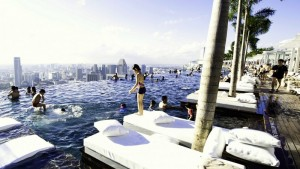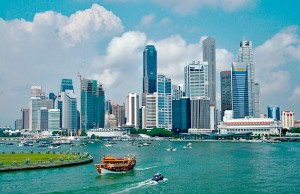Lunch Magazine: Clean Green Singapore
Thursday March 31st, 2011 2011, In the News
URL:http://lunchmag.com/clean-green-singapore/
And because of our size, Singapore is like a test-tube as innovations can be rolled-out quickly.

Water self sufficiency is vital … the infinity pool 57 stories or 200m up in the sky in Marina Bay Sands
It is one of the most densely populated nations on the planet yet Singapore also happens to be one of the most resource efficient. With virtually no resources of its own to speak of and little access to fresh water, the island state is very near self-sufficient in its utility needs.
More pertinently, the country is starting to export its innovations to the world.
Water is a key example of the Singapore Government’s innovative drive to self-sufficiency. Up until recently the country relied heavily on the importation of water from Malaysia, which was riven with a number of difficulties both economic and political.
In recent years the government has endeavored to future-proof water supply by turning away from Malaysian imports. This has been done by increasing the catchment area to around 66 per cent of the island, the construction of better desalination plants and recycling water branded as New Water by the government.
By expanding the catchment area, the island which receives four times more annual rainfall than London and twice that of New York has been able to harness its natural advantages. Nowadays, the central Marina Bay area bordering the South China Sea is a freshwater reservoir providing up to 10 per cent of the island’s water needs. Moreover, the reservoir is bounded by an ingenious barrage designed to not only keep the saltwater out but to also release freshwater when there’s a period of heavy rainfall.

Beyond water, the Singaporean Government has made a strong commitment to becoming a smart energy economy. In a speech late last year, Prime Minister Lee Hsien Loong, said the country’s aim was to build a smart energy economy that is innovative, resilient and sustainable.
We are developing a long-term energy master plan and sustainable development master plan to guide the evolution of Singapore’s energy landscape, he said.
Not surprisingly, the government is all about moving towards sustainability in a competitive business-friendly environment.
In his speech, the prime minister said the country fosters competition in producing and supplying energy so as to operate efficiently and respond nimbly to changing conditions.
We should also work through the market to deal with carbon emissions, he said.
And while Mr Lee acknowledged efficiency gains are important for more efficient use of energy, they also lead to greater usage. The key was a price on carbon, which the Singapore Government is already factoring into its cost benefit analysis of energy usage.
According to the CEO of Singapore’s largest energy company, Senoko Energy, Brendan Wauters, a key factor in making Singapore greener and more efficient has been the move away from oil-fired power stations.
We have moved to being gas-fired in the space of a decade as our power stations were 80 per cent oil-fired up until the late 1990s, he told Lunch Magazine.
Mr Wauters says natural gas is the key to Singapore’s energy future because the country is not well-endowed with renewable such as wind or solar.
Prime Minister Lee said the country’s newly-built LNG terminal would be ready by 2013.
This will allow us to plug into the global gas market and access gas sources from around the world, he said.
Mr Wauters said Senoko have been bullish on the LNG front and they have converted existing technology into highly-efficient gas turbines and they’re investing more as the government’s LNG project comes online.
Very few markets have made a transition from oil-fired to natural gas in such a short period of time and we’ve already seen a significant reduction in our carbon footprint which has won us acclaim around the world, Mr Wauters said.
Coupled with cleaner energy, the Singapore Government’s efficiency drive is epitomised by a local company IEQ Global.
The company’s executive director, Ong Wei Ping recently said that IEQ Global’s focus is on providing solutions and consulting services to Singaporean companies keen on improving their overall Green Mark. The Green Mark follows legislation stating not only all new buildings must have a green rating which is similar to here but older buildings also have to be accredited in the next decade or so. IEQ are one of the founders of the Singaporean Green Building Council and have assisted the Government become the leading green economy in Asia.
In older buildings, IEQ improve efficiency work on simple things such as changing lights and treating air-conditioning with a biodegradable enzyme, which makes them operate more efficiently.
We look at UV-coating windows, LED lighting and treating toilets with a titanium dioxide which stays permanently on the surface and lessens the need for water. Already we are looking at the older housing estates and MRT (subway) stations to improve their efficiency and usage.
We are lucky in Singapore because we are a small country meaning we are easier-to-manage. We also have a strong government and legislation goes a long way here.
And because of our size, Singapore is like a test-tube as innovations can be rolled-out quickly,.
Interestingly, it’s a country not blessed with natural resources yet its focus on energy efficiency and commitment to pricing carbon is branding it a leader internationally. Moreover, the country’s push to greener water and energy solutions is already seeing it export its innovations with a number of countries in the Middle East keen on exploring the Singaporean approach already.
At the same time, the government is forging ahead in the search for new energy sources recently investing $ billion in energy R&D.
According to Mr Lee, the country’s aim is not to make a major breakthrough on new energy sources.
We are not researching fission or cold fusion. That would be beyond our scope. But we can come out with many good ideas in areas such as energy consumption and distribution or urban design to cut our energy intensity.
Mr Lee also said the country had attracted major players from the industry to set up their operations in Singapore.
For example REC, Renewable Energy Corporation, has made Singapore its home for one of the world’s largest integrated solar manufacturing complexes. Vesta’s, the wind-power company has established its global wind R&D centre here.
We encourage more companies to plug into this vibrant ecosystem and research network to develop energy solutions not just for deployment in Singapore but also to be exported to the region and to the world.